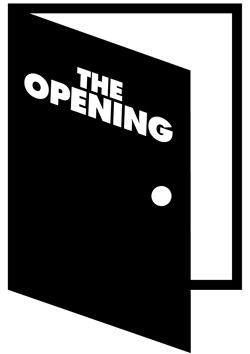 |
THE OPENING is all about introducing the fascinating, quirky and wonderful people working in and around the visual arts in Vancouver. Each week, we’ll feature an artist, collective, curator or administrator to delve deep into who and what makes art happen! |
Raised between Victoria and Gooch Island, and now living and working out of Vancouver, Meghan Paterson has made a firm name for herself in both the local art community and in the local retail community, two worlds that see a lot of overlap. After getting back from a small research and collecting trip in California, Meghan invited me to her studio space off Powell Street. We talked Barry McGee and Gabriel Von Max, local fashion and light reading. Meghan showed me collected ephemera from Refuge Cove, photographs, and older work.
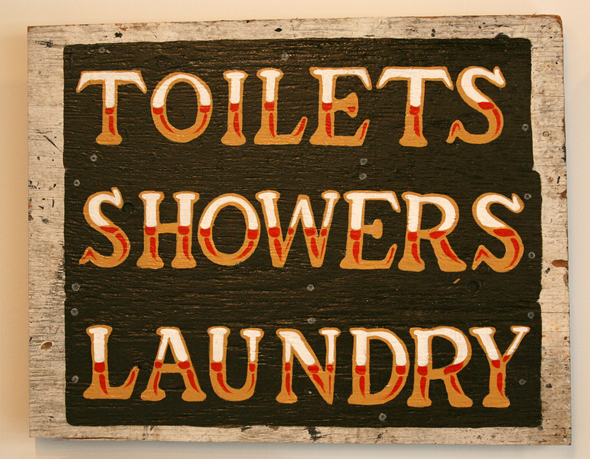
'Toilets Sign' 16.5" x 21"
Refuge Cove was the inspiration behind your last big body of work, Safe in Camp.
Refuge Cove was one of those subculture niches. I'm interested in these little bastions of community, niches that are super relatable, not entirely to the average person, but not entirely obscure. And the thing about Refuge Cove is that it's going to change a lot in the next five years, and it's not going to exist how it is even now. Everyone there is getting older. Younger people aren't moving in. It's too expensive, and not many of the co-op members had kids. The family I stayed with, Matthew and his brother Alistair, are involved and they opened a gallery with their mother, and I helped with it. This summer they bought the cafe, and they're putting new blood into the community, but it is a community in decline. It was good time to document it.
You were brought up there, and the trade was to set up a gallery space.
Yeah, I helped them with the store. It's like a gallery shop. I helped them with that, because I've done that kind of stuff forever. It worked out perfectly because I got to have a space to paint and do a residency with them. And I actually went back this summer, too. The first time I was there, I went from the beginning of July until the middle of October. And honestly, September-October up there is the best. It's quiet, and you really notice the season change. More so than in the city. You get that crisp sort of feeling in air, and there's woodsmoke. It's really nice. It's cold, and then you really have to think about things: they turn the generator off, the store's closed, you can't buy groceries, you've gotta think about firewood. There's about seven people that live up there in the winter time. Only a couple of them are co-op members. Others are people that have float houses that pull them in for the winter. Because no one really wants to be up there then. It gets really bleak. But they're caretakers, in a way.
Refuge Cove turns forty this year, the co-op. What I want to do is a book of paintings for that, as a recognition of the community and the co-op. I've started blogging about them. I've just started doing it because I have so many photographs of them all. Barry with his welding caps is my favourite. I'm going to start posting more of that stuff. At the show [Safe in Camp at Catalog Gallery], people were really interested in the stories. But at the same time, I don't want to exploit them. It's finding that sort of fine line. There are people who live out in the middle of nowhere because they don't want people to know who they are.
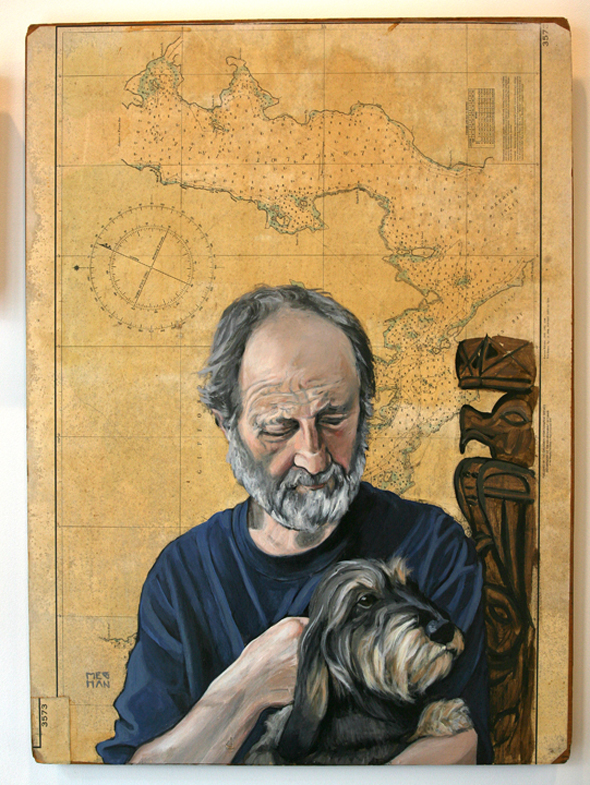
'Reinhold and Fritzchen' 21" x 31"
One thing I really wanted to do was, there's this one guy up there who is the best story-teller. His name is Uncle Don, and he's my favourite. I didn't end up painting him. He's one of those guys who, when he's telling you a story, he's very animated, and he's very pragmatic. The stories up there are insane. Anyway, Don's such an amazing story-teller. I wish I had the forethought to record them all. It would be amazing to stand in front of a painting of this guy, Reinhold, the guy with the dog, and hear Don telling a story of how the cougar got into Reinhold's house, and he had it by the tail, and it had his dog in it's mouth, and all this shit was happening, and they shot it in front of a fireplace like a carpet. In Don's gravelly amazing voice.
What did yours subjects think of your work when they saw it?
Most of them are pretty humble. They were very supportive. I was very lucky because they let me behind the fold. I got to be involved in the community without actually being a co-op member. Everyone came by to see them. I took back up what I had left from the show.
You painted replicas of the signage that you saw there.
Because the signs up there are so amazing. I would have loved to have stolen the signs. Some old guy painted them a million years ago. I think he was a pin striper, definitely a sign-painter, because they're perfect and they're all one shot. I didn't even do them justice at all. The ones that were starting to wear away and get very weathered, they were the best. All the materials i painted on are from up there. And this last trip, I brought a lot of materials back. I didn't actually paint a lot this summer. I was too busy helping with the business. But I took a lot of photos. Not a lot has changed. No one's bought or sold or anything. They're mostly doing the same jobs. But it was a different kind of summer.
You worked in the clothing industry. You know the merchandise that's popular, that sells really well on the West Coast, and how much that aesthetic draws on this specific culture. To a point, it can be kind of exploitative. As someone operating in both worlds, what are your thoughts?
Well, it's funny because I had Mr. Lee's General Store, which is a men's store that sold all this kind of stuff, that sold work shirts and work boots and toques, wet-weather gear and all this kind of stuff. And I suddenly ended up living in a place where the dudes that were wearing this stuff had been wearing it for thirty-five years, the same shirts. And they didn't care. It was just their stuff. It's gear that is functional. It makes sense. You need to be warm, you need to have your raincoat on. I didn't intend to paint these guys because of anything trend-heavy. It just sort of worked out. I thought it was a good time to show them because of popular culture and the trending towards back-to-the-land hunting/fishing sensibilities, but it wasn't intentional. It just was kind of ironic.
Why do you think we need that culture back so badly?
I've thought about this kind of stuff a lot, because I'm very interested in where trends are going. I don't want to go off on a tangent about Vancouver. I don't think there's anything wrong with Vancouver. It's just very young. It doesn't have the sort of infrastructure and all the cool shit that most cities have because no one stayed here to make it cool. People now are finally opening stores and opening restaurants, and getting more interested in food culture and cocktail culture and fashion. Vancouver is known as the raincoat, David-Suzuki-jacket-wearing—
Yoga pants...
Yeah. But that's besides the point. It's because nostalgia is the new black. It's so heavily prevalent in almost every artist's work that I know. That's what popular culture is right now, this sort of throw-back to things that remind you of your grandfather, your childhood. This is my childhood. This is how I grew up, so for me it's a very personal nostalgia. But it's also the idea of having very quality things and not buying disposable clothes. Which in itself negates the fashion industry, because the turnover with fast-fashion is so quick that your plaid shirts can be out of style in two years. But again, these things are classic, so they don't really ever go away.
There's two sides of the coin. There's fast-fashion, like H&M, Forever21. They have six seasons instead of four. They're constantly constantly producing. Their clothes are made like shit, and they're all made in undeveloped countries. The flip side of that is buying this beautiful wool sweater made in Finland, or buying an American-made boot, or what have you. These are two things happening at the same time that are opposing. The cheap-and-quick is never going to go away, because people can't afford to buy the other.
Will you speak a bit about your own personal upbringing?
When I was a year old, my parents got a care-taking job out of the newspaper in Victoria for a little tiny island called Gooch Island. And so I grew up there almost entirely till I was four, around the time my sister was born. Then I went to school in Victoria. For the rest of the time I went back and forth from city to island: island on weekends, school week in the city. All my summers were on Gooch Island, and holidays. It was a very free and incredible childhood. There was no tv, no phones. There was a generator for power. And there was being outside. Or inside drawing and reading. As a teenager I hugely rejected it, because I was never in town for sleepovers and parties and kids' stuff, and because I was the weird kid who wore homemade clothes and wanted to draw all the time. I was very excluded from city kid stuff. So basically, when I was thirteen or fourteen, my parents split up. I never had to go back, which was sort of perfect. I never did. And then I became very heavily into the city, and fashion and music and art, with galleries and stores and what have you. I completely distanced myself from where I came from. My sister did the opposite. She stayed working on farms, like on Gabriola. She kept going to Gooch island.
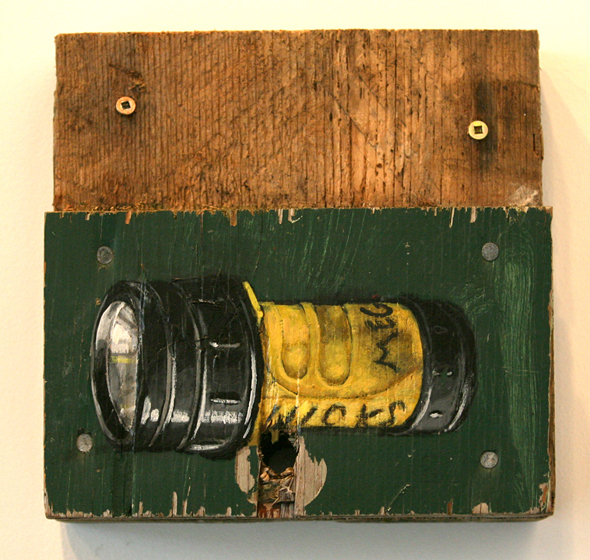
'The Wick Stick' 8" x 8"
As we've both gotten older, we've both found a middle-ground. I turned thirty, and I ended up back in a place which was so much like where I came from. I suddenly realized that this was all I wanted. I need both, the city and the country. Being able to be in the city in the wintertime and be up there in the summer is the ideal for me. And my sister works on a farm in Gabriola, and in the winter she goes and lives in Europe, in cosmopolitan cities. So we've found a middle-ground, which is interesting having gone in diametrically opposing directions.
Alana Paterson is an accomplished photographer.
She's really good and she's doing really well.
And your work also has a photographic aspect to it. Do you work from photos?
Yeah. I do.
And you have a heavy figural focus, but you also paint signage, still lifes...
Well this is new. I've always painted people and portraits, but I've never really painted stuff. I wanted to give these guys some kind of context. And I think that it worked out well in that it gave a full feeling, the buildings and boats and stuff. There were thirty-eight paintings in that show. I wanted to show them salon style, as vignettes. I really like the floats, the buoys. Everyone has their own, because everyone has their own traps, and everyone has their own floats, either with “Refuge Cove” or their last names on them, or their numbers or different colour stripes. Its cool to mix up individuals with their tags, almost. And their boats and their houses. I wanted to show it as it us up there. When you look around, there's so much cool stuff up there. I wanted to have the complete story.
Some of the pieces of what I found were so amazing. The turquoise painting of the guy holding a beer. That piece of wood was so good. Someone had spray-painted on it. It had rust spots. Other ones are not as amazing, but they're useful and they'll work. I like to have the background showing. It gives it texture. All the buildings are in this state of decay. That's the beautiful part of it. It mirrors the community in a way.
The charts were a total bonus. They're from the general store. Someone varnished them to be on display in the general store, to sell the charts to boaters. They were just up in an attic rotting. I put up a notice in the general store saying, “Meghan from the gallery is looking for old pieces of wood and signs, life jackets, paddles, whatever you guys got under your houses.” And the girl from the general store came over and asked if I could use them. It was the mother-load.
It's an incredible backdrop. And then you're placing people onto a geographic map. And you paint yourself in there.
I did. I didn't know if that would seem weird, but it was a huge transition for me. I mean, it's Refuge Cove, and it was a refuge for me. I came back to a huge part of myself that I had been ignoring for my adult life.
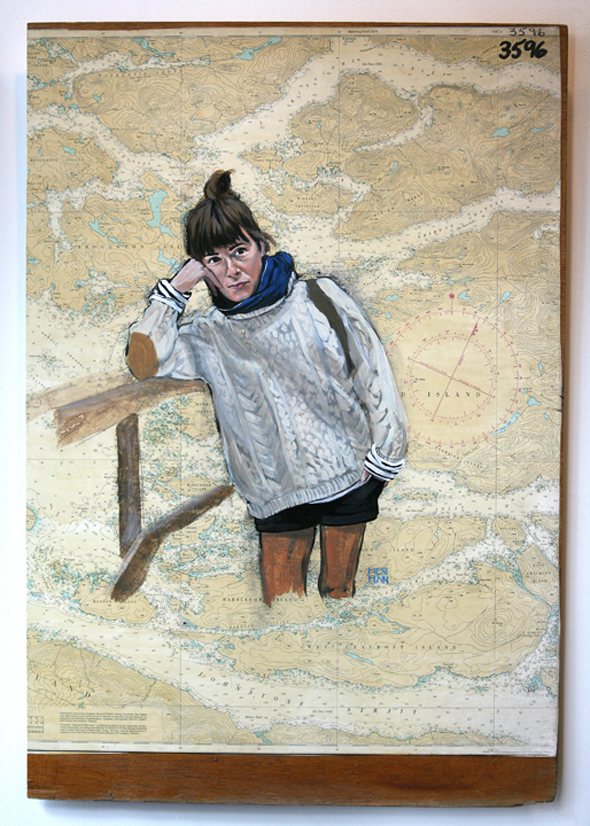
'Meghan' 21" x 31"
So beyond this project, what are your general subjects?
This was the first project where I was pulled in a specific direction. I've always been painting, but I've never had a coherent concept. This has been the best story that I've told. But I want to tell some more stories, now that I've got here. There's something that happens when you get a little bit older, I think. Also, the universe had something to do with it, just going, “Hey, remember how you never had the balls to quit your job and put all your stuff in storage and just f*ck off?”
There's this resurgence in escaping to the woods. I guess it isn't a resurgence, it's just that now people are paying attention to it more, to people going out to the woods and hermiting.
That's this whole thing. These guys were very idealistic, and in their thirties they found this piece of land, got together, bought it. They had all just graduated from the Vancouver college. They were all on this back-to-the-land kick, saying, “We're gonna hunt and fish and have babies and feed our families, and live off the land!” There is a big resurgence of that right now. Everyone wants to go fishing and hunting. People are going out to the islands and up the coast. People are buying cabins. Even urban gardening, and people keeping chickens in their backyard.
Do you think you'll go back a third time?
Of course I'll go back up there. I love the place. I don't think I'll continue painting it. I'd really like to go further north, and I'd really like to go to the Yukon. I imagine all the old guys up there, all the old metal signs, all the old Miner-types. You know something that happens with these guys, and the thing about the coast, up that far, was that in the old days you could go up there, set up tent and just hang out. There's all kinds of stories of people going up in the summertime and getting driven out by the winters. Grant Lawrence's Adventures in Solitude has an old hippie guy that lived up there and becomes a good friend to him as a kid. These guys go up there and eventually they get bushed. Some killed themselves, many became incredible alcoholics. It gets to the point where they can't cope being somewhere so isolated and so dark and cold. Very few people make it out of that alive, the year round residents.
So your subject matter has a two-sided element.
The summer times are amazing. The winter times are hell. Captain Cook named it Desolation Sound for a reason. He was so over it. “This place is f*cking awful.” But in the summertime it has the warmest water on the West Coast.
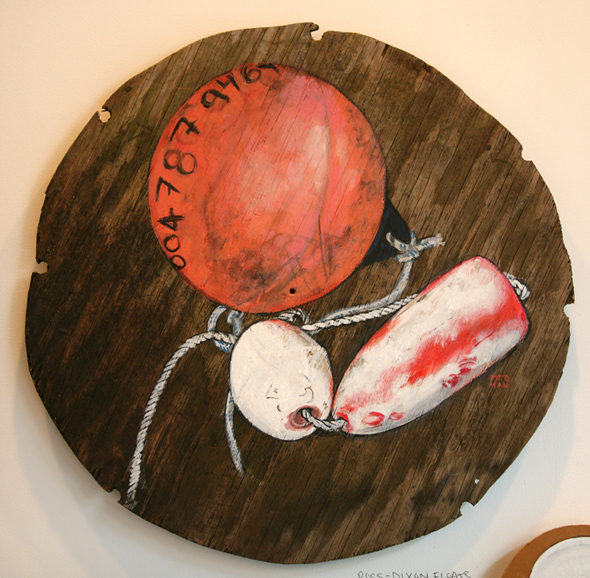
'Ross-Dixon Floats' 18" x 18"
You had a recent studio sale with Red Flag. You just wanted to clear out your studio?
Yeah. There's stuff I was painting before I went to Refuge Cove, and I can't come back to it now. It's very flat to me. It doesn't have any story. But you know what's interesting, people would look at these portraits and think they knew the person. And people read all this emotion into these girls that were really quite flat to me. It was mentioned that I gave these girls all these emotional depth. People respond to them on an emotional level, which is interesting. I've always been attracted to why people like certain things, and it all comes back to nostalgia. But that work is not as genuine. I might have a bonfire. Wouldn't that be awesome? Bonfire the vanities? My mother would kill me. She's been collecting all my throwaways for years.
I've always been passionate about painting, but I'm also very into retail stuff, store concepts. I've got some ideas brewing, I've got some plans. We'll see what happens in the next little bit. Art wise it's my big fear to follow up my first solo album with a sophomore slump. That's a tough thing. When you do something, go out to the woods, make something, it blows up. That's the formula! How many people have gone out to the woods, got their shit together, made something beautiful, brought it back, and people loved it. You can't mess with the formula. And Tom Thomson's hot. You can put that in there.
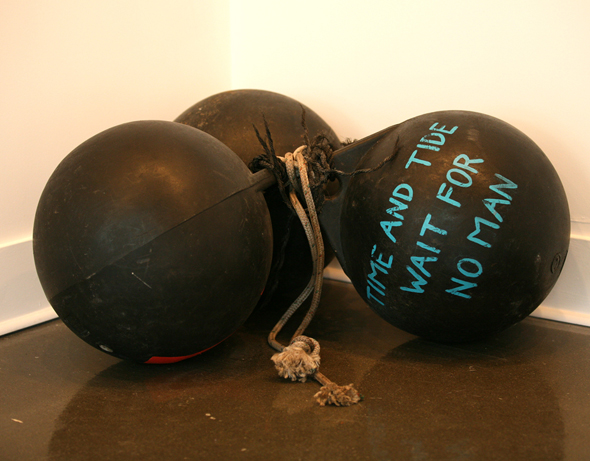
Meghan Paterson's work can be viewed at meghanpaterson.com, as can her ongoing blog. She currently has work for sale alongside other local artists and designers at Red Flag's REDFLAGDESIGN_SHOP, open for the Holiday Season. She is also amongst the artists featured in Catalog Gallery's Presence 2. Meghan will be opening a new store in Catalog Gallery called Lobby, which sells books, supplies, and items related to the programming in the gallery.
All images courtesy Megan Paterson.


